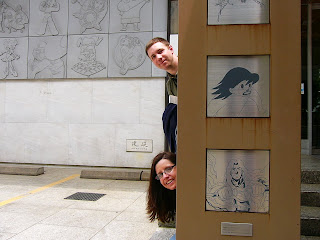Today was Kevin's pick, so we started out at the Suginami Animation Museum, which explains the history of Japanese anime and the techniques used to create the cartoons. The museum was a little off the beaten path, but through the kindness of strangers we were able to locate it. We actually stopped in a video store to ask for directions and the clerk was nice enough to walk us outside, orient our map to the street we were on and then trace out our path. Kevin said that if he need all kinds of permission to leave his register at Murphy's to help a stranger.
Much of the exhibit was in Japanese, but Kevin was able to identify some of the characters and cells for the different anime he had seen. There were also several subtitled videos showing how a cartoon is made from start to finish. I fear that handpainted cartoons may be a dying art like so many aspects of our culture right now. I am not a luddite by any stretch of the imagination, but I do value craftsmanship and seeing the artist's hand in their creation. This seems to be lost in digital animation.
The museum had several interactive areas, probably intended for children, but we thirtysomething-year-olds also found them quite fun. Robin, Kevin and I all tried our hands at tracing and coloring animation cells for popular Japanese anime characters.
The Ogikubo Hachiman Shrine was directly across from the museum so we also spent a few minutes walking through the shrine while we were in the area. I am really hoping that our tour guide explains some of the significance of shrines and temples. I have looked at so many of them in my travels through Southeast Asia. However, I don't fully appreciate their functions. I've noticed that Japanese shrines/temples have statues of dogs that wear red bibs and also a fountain in which you are to wash your hands. I don't recall seeing these in other shrines/temples.
We left Suginami and hopped on the Metro to Harajuku where we visited the Meiji Jingu gardens and shrine. The shrine was opened in 1920 in honor of Emperor Meiji and Empress Shoken, who were instrumental in opening Japan to the outside world after the end of the Edo period. The entry gates to the forest area, called torri, are the largest in Japan, built of cypress trees that are more than 1,700 years old. Once inside, it was hard to believe that we were even in a city. It was more like walking through the forest. Kevin said it smelled like being at Boy Scout camp. I later read that the forest was actually carefully planned and planted so that so that it would constantly recreate itself and be indistinguishable from a naturally occurring forest. We saw the lake which was the emperor's favorite hunting and fishing spot and was the only part of area that existed prior to the creation of the shrine and forest. We were fortunate enough to be able to see the Iris Garden, which is only in bloom from late May through early June. This was originally designed by the emperor specifically for the empress. There are currently 150 different species of iris blooms in the garden.
The original shrine was destroyed in the bombings of Wold War II, but the reconstruction is supposed to be authentic to the original. While I may not understand the significance of Shinto shrines, I do love the symmetry and repetition of their architecture. This particular shrine is a popular wedding spot and we were fortunate enough to be able to see a wedding procession. The bride was dressed in a traditional outfit and was flanked by other attendants. The procession was led by who I assume was the priest as he initiated the chanting once inside the shrine.
We finished our day at Tokyo Tower, another must-see on Kevin's list. The tower was built in 1958 and is modeled after the Eiffel Tower except that it is bright orange. We took an elevator up to the main observation deck 149 meters (489 feet) up, and were able to get a 360-degree view of Tokyo. Next, we took another elevator to the special observation deck 248 meters (814 feet) off the ground. We timed the trip so we could see the sunset and the lights begin to come on over the city. Unfortunately, it was very cloudy so no sunset. Missing the sunset seems to be another recurring theme in my travels. The city does look beautiful at night, though.
Tokyo Tower has a cafe on the first observation deck level, so we decided to have adinner there. Kevin and I tried a chicken sandwich with soy sauce and an egg on top. It was actually very good and even Kevin had no complaints. Of course, what dinner would be complete without ice cream sundaes? The sundaes had cornflakes in them just like the ones we had in Vancouver. Must be a Japanese thing.














No comments:
Post a Comment